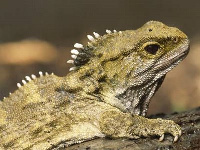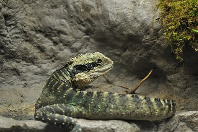
Crocodilians
Crocodiles (subfamily Crocodylinae) or true crocodiles are large aquatic reptiles that live throughout the tropics in Africa, Asia, the Americas and Australia. Crocodylinae, all of whose members are considered true crocodiles, is classified as a biological subfamily. A broader sense of the term crocodile, Crocodylidae that includes Tomistoma, is not used in this article. The term crocodile here applies only to the species within the subfamily of Crocodylinae. The term is sometimes used even more loosely to include all extant members of the order Crocodilia, which includes Tomistoma, the alligators and caimans (family Alligatoridae), the gharials (family Gavialidae), and all other living and fossil Crocodylomorpha.Although they appear to be similar to the untrained eye, crocodiles, alligators and the gharial belong to separate biological families. The gharial having a narrow snout is easier to distinguish, while morphological differences are more difficult to spot in crocodiles and alligators. The most obvious external differences are visible in the head with crocodiles having narrower and longer heads, with a more V-shaped than a U-shaped snout compared to alligators and caimans.

Snakes
Squamates are the most diverse of all the reptile groups, with approximately 7,400 living species. Squamates include lizards, snakes and worm-lizards. Squamates first appeared in the fossil record during the mid Jurassic and probably existed before that time. The fossil record for squamates is rather sparse. Modern squamates arose about 160 million years ago, during the late Jurassic Period. The earliest lizard fossils are between 185 and 165 million years old.

Tuataras
Tuataras are a group of reptiles that are lizard-like in appearance but they differ from the squamates in that their skull is not jointed. Tuataras were once widespread but today only two species of remain. Their range is now restricted to just a few islands in New Zealand. The first tuataras appeared during the Mesozoic Era, about 220 million years ago, about the same time the first dinosaurs appeared. The closest living relatives of the tuataras are the squamates.

Squamates
Squamates are the most diverse of all the reptile groups, with approximately 7,400 living species. Squamates include lizards, snakes and worm-lizards. Squamates first appeared in the fossil record during the mid Jurassic and probably existed before that time. The fossil record for squamates is rather sparse. Modern squamates arose about 160 million years ago, during the late Jurassic Period. The earliest lizard fossils are between 185 and 165 million years old.

Turtles
Turtles are among the most ancient of the reptiles alive today and have changed little since they first appeared some 200 million years ago. They have a protective shell that encloses their body and provides protection and camouflage. Turtles inhabit terrestrial, freshwater, and marine habitats and are found both in tropical and temperate regions. The first turtles appeared more than 220 million years ago during the late Triassic Period. Since that time, turtles have changed little and it is quite possible that modern turtles closely resemble those that roamed the Earth during the time of the dinosaurs.